#trek musing
Explore tagged Tumblr posts
Text

Absolutely shocked this didn't show up in Lower Decks. Like, Boimler is wearing it as an homage to Kirk but everyone thinks he hates Kirk and he's stressed out over everyone thinking he hates one of the most beloved captains of his time.
This is the B plot in an episode where the A Plot is one of the most serious stories of the season btw
#star trek#star trek lower decks#star trek the original series#TOS#LD#james t kirk#kirk#kirk is a jerk#bradward boimler#boimler#star trek the animated series#TAS#trek musing
183 notes
·
View notes
Text

she'd stab me and I'd be so thankful if I'm being real
print available
#i'm only HUMAN#and she's everything#uuurrhhh#my muse for real#click for better quality#james t kirk#Jim kirk#Star trek#St tos#tos#St aos#aos#my art#art#digital drawing#drawing#illustration#mirrorverse#mirror mirror#spirk#mckirk#choose your fighter honestly#Fanart
1K notes
·
View notes
Text
And here we see baby Julian definitely not checking out the weirdly forward alien Miles just brought past the infirmary:
Look at him! The way he does a little double take. The look of wonder in his eyes. The surrepititious down-up glance as Tosk walks away :3
463 notes
·
View notes
Text
yeah so theres this android in my brain. hes not paying rent.

#this is all lyrics(?) from uhhh muse; starset; spiritbox; badflower; fontaines dc. hope i didnt miss anything LMFAO#graphic design is my passion *dies*#data soong#star trek#star trek tng#data tng#star trek data#star trek art
222 notes
·
View notes
Text
I love Vulcans we need to get more into the emotional lives of Vulcans without imposing Human standards onto them. "The way you feel is wrong/repressive because it's not the way it's "supposed" to be from my perspective as an alien called Human" is boring to me especially when it's treated as correct. I wanna know how the aliens feel about their alien way of life. Vulcans are so interesting to me when written AS aliens and not as analogous to repressed Humans. I think about Tuvok's description of attachment to his family and how that isn't the emotion 'love' but something else, something that he feels no shame about having and sees as normal, as naturally Vulcan and I love it and I love it because there aren't any Humans there to go "Um actually checkmate you Vulcan s.o.b - that's emotion!" and he isn't being influenced by anything. These are his authentic thoughts. He sees his children, his family, as part of him. They were at times illogical, incomprehensible, and it was extremely rewarding to be in their lives. He thinks about them every day. They were well behaved. As teens they were contemptuous of authority and convinced of their own superiority. His youngest son loved one 200 verse story so he sang it to him. He'd rather die than betray his wife even in spirit. He's incomplete without them. It's obvious through Tuvok that Vulcan life is not inherently devoid of pleasure, comfort, or love and thus Human life (I think) should not be portrayed as inherently having something greater, deeper, more meaningful. I'm not talking here of society but of...emotional life. Interiority. There's this sense that all Vulcans are the same and miserable for it. That they hold themselves back and are indistinguishable and antagonistic to the self, repressed and wrong. That to be Vulcan is to suffer endlessly and Humans are all about Freedom Man and I don't know, I like that Tuvok's existence sort of challenges this as much as I acknowledge that Vulcan society is in fact repressive and unwelcoming to those who don't fit neatly into it. I'm not saying Vulcan society is a utopia, I'm questioning the perception of Vulcan emotional control - that way of life - as being inherently bad, devoid, or lacking. That Vulcans walk around with 'empty cups' and are only deluding themselves that to be that way is good. If only, Humanity moans, they could taste how delicious life could be! Tuvok is an average Vulcan. He does not struggle with emotion, he is not mixed species, he was not raised atypically, and yet he has a family he cares about and a wife he's loyal to and friends he values and none of these things seem to be Un-Vulcan to him. If Vulcan life was truly devoid of love and care, Tuvok wouldn't think of his family. They're not here, so why bother? When his pon farr came, he'd be trying to find the most compatible mate rather than risking his life by trying to meditate through it out of loyalty to T'Pel. T'Pel would also have just given Tuvok up for dead instead of waiting and his children wouldn't have traveled all the way to the most holy temple on the planet to say prayers for his safe return. I think these things are interesting and I wish they'd been explored more. The fact that caring about your family, caring about your friends, is not Un-Vulcan. The fact that Tuvok at no point longs for Humanity, sees nothing better or of interest to him in it. (Even in his teenage rebellion he only says he's sorry he was born Vulcan which reads less as Vulcan v Human and more like 'I hate this goddamn family' ykwim?). I want to know more about how Vulcans interact with each other, how they care for one another, what it means and what it's like to be Vulcan in more of an everyday way rather than what it means to be Vulcan vs Human.
#Vulcan emotional control WOULD be bad for Humans. But they're aliens. So.#I wrote this off the cuff v_v sorry if it just rambles in circles#I just don't like when Vulcans are written to be 'like us but missing out on something beautiful'#I think of people who don't live anything close to my life's experience. Are they lacking in something? Are they not living a 'full' life?#I'm not neurotypical - am I missing something essential to living a 'real' life because of that?#some people don't experience empathy - are they lesser because of it? No#I love my fellow man I guess. I think maybe in the far far future I'd hope that being just like me [human = neurotypical white american]#isn't a prerequisite for friendship and love and maybe we can just have harmless and beautiful differences#I wonder what's so good - INHERENTLY good about having emotion. What does it mean to be good? What does it mean to live 'fully'? As a Human#As an Alien? What does it means to have a life? Be alive? What's love and why is it important? What do these concepts mean to an Alien?#In Star Trek Voyager Ayala's son and Tuvok's son both pray for their father to come back home - is the Vulcan prayer lesser?#All this to say that I /AM/ going to make my own no-emotions aliens to put in star filled oyster - you just know I'm going to do that#there was no other option for me it was written in stone from oyestar's conception and I hope you'll all read the story#I eventually write with them even though you'll no doubt raise your brow and look me in the eye and go 'oh big surprise the Vulcan guy wrot#this. Oh hey look everyone the autistic Vulcan guy is musing about emotions what a surprise' and I'll be tugging at my shirt collar#like a cartoon character and gulping comedically and sweating bullets#Literally as I wrote that last sentence I realized I'm dissociating I'm going to go eat ice
101 notes
·
View notes
Text
why do i feel like so often in Star Trek the dynamic is:

#'oh you want to push the ship 20 times past the safety limit? of course you do. oh you want the thing that#will take 23 hours done in 30 minutes. sure why not.'#Star Trek#gen#humor#random musings
1K notes
·
View notes
Text
Tumblr wasn't lying. Star Trek: Enterprise really does have scenes with egregious close-ups of the cast oiling themselves up in their underwear
66 notes
·
View notes
Text

i saw a post that was like "the reason bones is always frowning is bc whenever he smiles, everyone in a 3 mile radius falls madly in love w him" and i think that is so true tbh
(anyways bonus spones scribble. ur welcome:
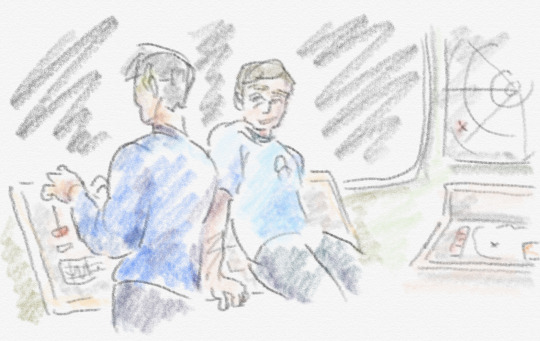
#star trek#star trek tos#tos#leonard mccoy#bones mccoy#spones#spock#spock/mccoy#deforest kelley#by god i have like 3 reasons left to live and de's smile is a good 2.5 of em#ok like all jokes aside im fine?? generally lmao#but i have a KILLER headache#and i spectacularly screwed up a midterm but im avoiding prepping for my next one tmr out of pure spite#jfc#ive been on an art and writing kick for the last few days it is absolutely DIRE#hell of a first post really#but yeah deforest kelley is so so pretty#ow my head#im being puppeteered via my hair by the muses and i have no control over my creations but damn wish me luck tmr im well n truly screwed#but hey DEFOREST KELLEY<3333 so worth it
348 notes
·
View notes
Text
An Odo/Lwaxana fake marriage ploy was not on my DS9 bingo card
Especially not in the same episode where a different psychic milf slurps Jake's life force through his brain but ok
also, missed opportunity to force Worf to deliver another baby
47 notes
·
View notes
Text
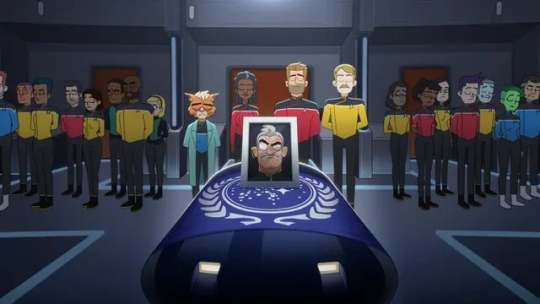
I can only imagine the version of this show where Shaxs stayed dead and we missed out on 4 seasons of arguably the best member of the bridge crew. Just think about the classic moments we wouldn't have gotten with him.


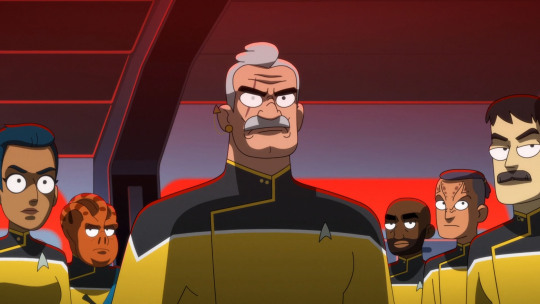

Say thank you Shaxs for coming back from the Black Mountain.
#star trek#star trek lower decks#lower decks#trek#st ld#st lwd#shaxs#lieutenant shaxs#uss cerritos#No Small Parts#wej duj#Hear All#Empathological Fallacies#Upper Decks#trek musing
163 notes
·
View notes
Text
Unpopular opinion- Captain Bashir of the mirror universe is not rakishly unlikeable in a charming way, he's just unlikeable, period. I can take or leave most mirror universe episodes anyway, but it's disappointing that Julian's mirror counterpart is pretty underwhelmingly written compared to most of the other main characters.
Prime Julian in contrast is occasionally endearingly unlikeable and cringe in a secondhand embarrassment kind of way (that I as a fellow bi autistico find incredibly relatable).
30 notes
·
View notes
Text
AU where Julian's been a little more open about his family - like, far from everything, but at least they all know the vibes aren't great. So when they come to the station he's like "Help can anyone be my fake date tonight for dinner? Don't want to do this on my own..."
Jadzia's obviously like "Here for you, but let me check with Worf" - but then to everyone's surprise, Worf replied with. "No. I shall fake date Doctor Bashir. Your parents would not dare belittle the mate of a Klingon."
And that's that.
(alternatively, Worf says "Lying is dishonourable. But Jadzia and I are willing to enter into a relationship with you" - I'm not sure which option I like better)
#Worf/Julian#Worf/Jadzia/Julian#This isn't very much written out I know#I think there's more there but not in my brain right now#Julian bashir#My trek musings#Wsb
236 notes
·
View notes
Text
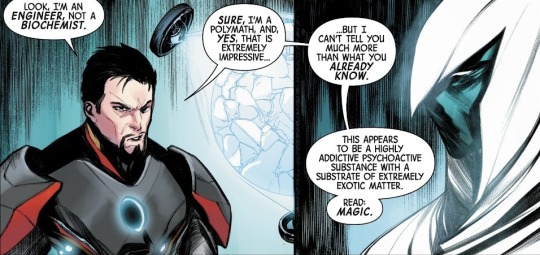
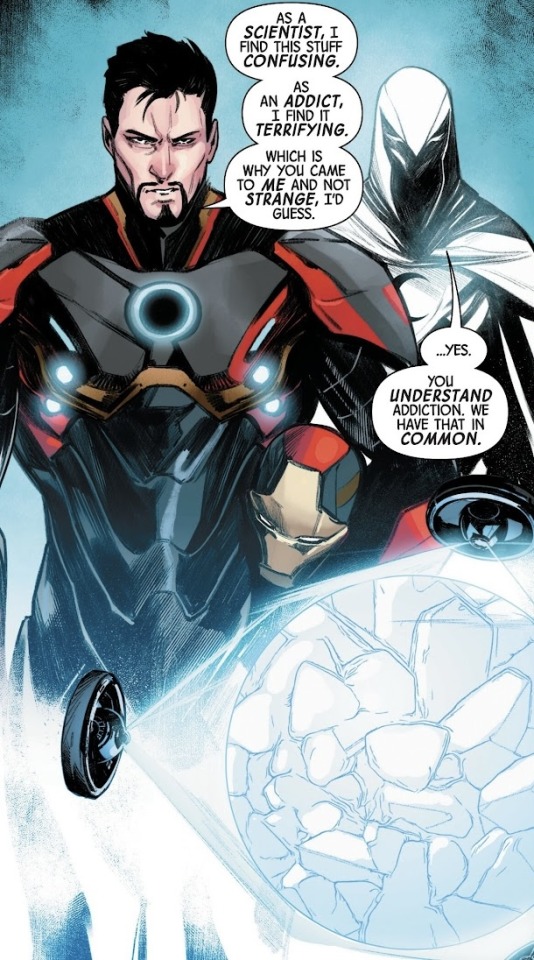
“Reborn,” Moon Knight: Fist of Khonshu (Vol. 2/2024), #2.
Writer: Jed MacKay; Penciler and Inker: Alessandro Cappuccio; Colorist: Rachelle Rosenberg; Letterer: Cory Petit
#Marvel#Marvel comics#Marvel 616#Moon Knight: Fist of Khonshu#Moon Knight: Fist of Khonshu vol. 2#Moon Knight: Fist if Khonshu 2024#Moon Knight comics#latest release#Moon Knight#Marc Spector#Iron Man#Tony Stark#you can’t tell me Mr. At One Point Had His Own Star Trek Uniform didn’t immediately clock the classic#«I’m a doctor not a…» set up hahaha#(Although maybe I’ve played too much Rainbow Six Siege because it also reminded me of Jäger’s «I’m an engineer not a medic!»#love that guy ANYWAY)#okokokok this is….interesting#I’m I guess you could say intrigued that so far it seems this volume is shaping up to make addressing Marc’s self-proclaimed addiction#to violence a central theme as it’s come up in both comics released so far#I guess I never thought they’d take it seriously since such descriptions of one reason why Marc does what he does is because he’s hooked#on the sort of high-octane rush that comes with combat have popped up in his comics for years#but that language was pretty common in 80’s and 90’s comics portraying tough guy characters willing to kill people#but it’ll be interesting to me at least to see how this more serious approach will develop#Mr. MacKay has given me little reason to doubt him so far but if they continue with this#idea of treating addiction seriously since they’re using the language associated with it I hope they’ll address it#with the appropriate gravity such a topic necessitates#anyway don’t mind me musing in the tags
53 notes
·
View notes
Text
dr. mora is such a #AutismWarriorMom. literally everything about what he says about and to odo, down to talking about him as a project that he's invested so much time and effort into. also his incessant commenting on his "progress" in "social integration" and willingness to humiliate him in front of his peers in order to make himself look better. and then he triggers a meltdown (in every sense of the word) to convince odo that No One Else Will Understand Him and Look What A Scary Oddity You Are To Normal People. frankly I commend odo's self-control in not wrapping a slime-appendage around mora's throat
40 notes
·
View notes
Text
you've got to be the best, you've got to change the world

#ik this is not the pinnacle of my works but guys im so tired#one day i'll not torture them but NOT TODAY hahahahahha#they are both so fucked up in their own way and i love them for it#i had such a cool blood spot for julian but ended up not using it because ripping up kukulaka is bad enough really. and the contrasttttt.#lyrics are: monster - starset; space dementia - muse; caption is butterflies and hurricanes - muse#graphic design is my passion *dies*#garashir#julian bashir#dr julian bashir#elim garak#ds9#star trek ds9#deep space nine#star trek deep space nine#star trek#star trek art#aaaand get up and fight starts playing what if i cried HHAHAHHAHAHAHAHAH#muse i love you muse
28 notes
·
View notes
Text
I forget that Odo isn't the only Security officer on DS9 and that ugly brown thing he wears is a station-wide security uniform and not just his personal fashion sense
36 notes
·
View notes